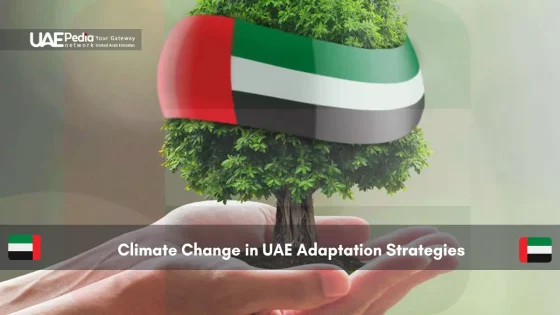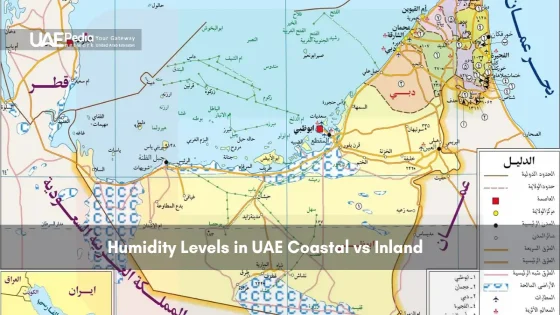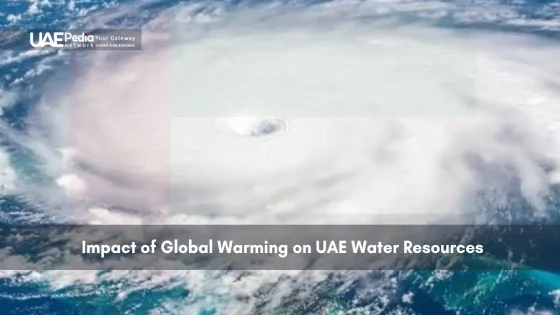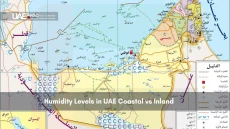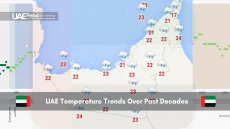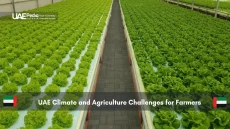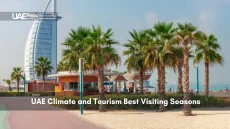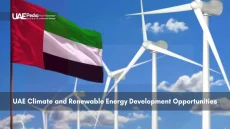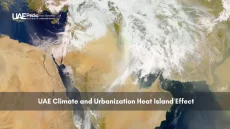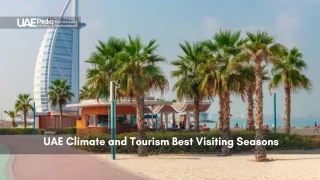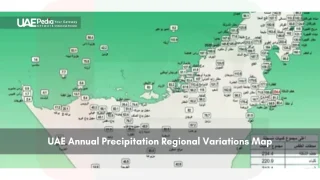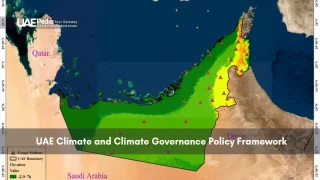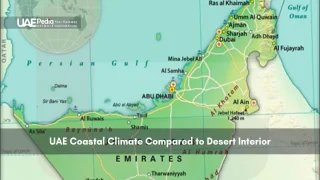What if a country built on oil could become a global leader in clean energy innovation? The UAE’s journey from fossil fuels to solar farms and hydrogen hubs reveals a bold blueprint for balancing economy and ecology.
Since joining the Climate and Clean Air Coalition in 2019, this sun-drenched nation has turbocharged its environmental commitments. Its greenhouse gas reduction targets leaped from 23.5% to 31% within two years—a pace faster than Dubai’s record-breaking skyscrapers rise.
But why focus on short-lived climate pollutants (SLCPs) like methane? These invisible culprits pack a heavy punch, accelerating warming and air quality issues. Cutting them delivers faster results for communities and sectors like agriculture and transport.
From ancient falaj irrigation systems to AI-driven water conservation, the Emirates blend heritage wisdom with tech-driven solutions. We’ll explore how coastal cities tackle rising sea levels, why renewable power projects now outpace oil production investments, and what these shifts mean for residents and visitors alike.
Key Takeaways:
- Discover how updated national pledges (NDCs) position the UAE as a regional climate action leader
- Learn why reducing SLCP emissions creates immediate environmental and health benefits
- Preview adaptive strategies for water security, energy transition, and future-proof infrastructure
Understanding the UAE Climate Context
Picture this: golden dunes stretching to skyscraper horizons, where summer thermometers flirt with 122°F. The UAE’s hyper-arid environment operates on desert time—scarce rain, relentless sun, and sands that reshape landscapes overnight. This isn’t just postcard scenery; it’s daily reality shaping everything from morning commutes to national policy.
When Rain Becomes Rarity
Annual rainfall here averages less than 4 inches—enough to fill a coffee mug across a football field. Combined with evaporation rates that gulp 75% of groundwater, every droplet gets treated like liquid gold. Farmers face a modern paradox: how to grow food in soil that’s 80% sand, using water resources scarcer than truffles in a supermarket.
Sandstorms and Survival Tactics
Extreme heat doesn’t just wilt crops—it warps metal and tests human endurance. Urban planners combat these conditions with heat-reflective buildings and mist-cooled walkways. As part of global climate partnerships, the nation invests in tech that turns seawater into drinkable reserves, proving innovation thrives where resources are thin.
Yet adaptation isn’t just about gadgets. Bedouin traditions of moonlit desert travel and date palm cultivation inform modern strategies. It’s this blend of ancestral wisdom and AI-powered weather prediction that keeps the Emirates dancing with the desert’s demands.
Impacts of Climate Change on the UAE
Imagine stepping onto a beach where waves lap at highway barriers—not some dystopian movie scene, but Abu Dhabi’s Corniche in 2040 if current trends hold. NASA satellites show waters creeping upward by 3.5 millimeters yearly, threatening to swallow 1,300 square miles of coastline. That’s like losing Manhattan… eight times over.
Extreme Weather and Rising Sea Levels
Desert heatwaves now hit 125°F—enough to warp train tracks and fry smartphone screens. But it’s the silent invasion of saltwater that keeps engineers awake. Critical desalination plants and power hubs along Dubai’s Jebel Ali face submersion risks with just a half-meter sea rise. As one IPCC report warns: “Coastal urbanization here dances on a shrinking stage.”
Effects on Infrastructure and Public Health
Last year’s freak hailstorm flooded Deira’s markets with knee-deep water—a $300 million wake-up call. Beyond flooded roads, shifting weather patterns brew trouble:
- Prolonged heat spikes ER visits for heatstroke by 27%
- Dust storms worsen respiratory issues across 40% of neighborhoods
- Salty groundwater threatens farm yields in Al Ain’s oases
Yet these challenges spark action. Hotels now retrofit AC systems to cut energy use, while developers elevate new projects like Dubai Creek Harbour—proof that sand and steel can adapt when the stakes crest higher than the tides.
Climate change in UAE: Government Initiatives and NDC Commitments
Think of a climate pledge as a sand timer—every grain counts. The Emirates flipped their hourglass in 2022, boosting emission reduction targets from 23.5% to 31% faster than a camel crosses shifting dunes. This isn’t just paperwork; it’s a blueprint backed by solar farms and hydrogen hubs blooming where oil rigs once dominated.
From Pledges to Partnerships
At COP26, the UAE became the Middle East’s first signatory of the Global Methane Pledge—a move cutting 30% of methane emissions by 2030. But here’s the twist: they’re not going solo. Through the AIM for Climate initiative with the US, $8 billion fuels agricultural tech to slash carbon footprints from farm to fork.
Abu Dhabi leads this charge like a falcon guiding the flock. The emirate’s National Air Emissions Inventory now tracks pollutants with satellite precision, while UAE Environment 2030 plan ties energy reforms to water conservation. Even fossil fuel giants join the dance—ADNOC’s $15 billion low-carbon push proves oil and sustainability aren’t sworn enemies.
- 2020: Baseline report sets 23.5% reduction goal
- 2022: Updated NDC adds 7.5% through HFC production freezes
- 2023: 40% clean energy mix achieved nationwide
As a Kigali Amendment signatory, the nation phased out 85% of hydrofluorocarbons since 2019—cooler ACs without heating the planet. These aren’t desert mirages. They’re real steps creating jobs, cleaner air, and a playbook other sun-scorched nations now borrow.
Innovative Adaptation Strategies for a Resilient Future
What if sand could drink seawater? The Emirates answer with reverse osmosis plants that turn Gulf waves into 900 million gallons of fresh water daily—enough to fill 1,364 Olympic pools. This desert nation redefines survival through tech that bends nature’s rules while honoring ancient conservation values.
Advanced Water Desalination and Management
Taweelah’s mega-plant uses AI to slash energy use by 40% compared to older systems. Solar-powered membranes filter salt with precision, creating drinking supplies for 350,000 homes. Farmers in Al Ain now irrigate date palms using sensors that match soil moisture to weather forecasts—like giving crops a digital thirst meter.
Renewable Energy Integration and Carbon Capture
Dubai’s Mohammed Bin Rashid Solar Park stretches wider than Manhattan, its 5 million panels tracking the sun like sunflowers. By 2030, it’ll power 1.4 million homes while cutting 6.5 million tons of CO₂ yearly. Nearby, ADNOC’s carbon capture system traps emissions from steel mills, storing them safely underground—a modern twist on Bedouin water preservation tactics.
| Technology | Impact | Project Scale |
|---|---|---|
| Solar Desalination | Reduces energy use by 50% | 1.2 billion gallons/day |
| Carbon Capture | Stores 800,000 tons CO₂/year | Equivalent to 170,000 cars |
| Nuclear Power | Provides 25% clean energy | 4 reactors operational |
These national initiatives prove environmental care fuels economic growth. New solar farms create 15,000 green jobs, while efficient desalination frees up gas for export. It’s adaptation with dividends—protecting communities today while powering tomorrow’s possibilities.
Economic and Infrastructural Adaptations
Ever seen a skyscraper wear sunscreen? Dubai’s newest towers do—literally. Heat-reflective coatings slash cooling costs by 35%, proving even concrete giants adapt to shifting environmental realities. Across the Emirates, cities reimagine growth through projects that shield communities while fueling economic resilience.
Reforming Energy and Industrial Sectors
Gone are the days when oil rigs ruled the economy. ADNOC’s recent $23 billion push cuts methane leaks by 75% across 300 sites—equivalent to planting 200 million trees. Factories now use AI to match energy use with grid demand, trimming consumption during peak heat. Even steel mills join the shift, capturing waste heat to power nearby farms.
Agriculture gets a tech makeover too. Vertical farms in Al Ain produce 20x more greens per acre than traditional fields, using 95% less water. These innovations stabilize food supplies while freeing up land for solar arrays—a win-win for resources and revenue.
Urban Planning and Coastal Protection Measures
Abu Dhabi’s new corniche isn’t just pretty—it’s armored. Wave-dissipating concrete blocks and elevated walkways defend against rising tides, while mangrove forests expand to swallow storm surges. Developers follow strict codes:
- Buildings elevated 1.5 meters above projected flood levels
- Permeable pavements reduce urban heat islands
- AI traffic systems reroute cars during sandstorms
| Project | Focus Area | Impact |
|---|---|---|
| Barakah Nuclear Plant | Clean power generation | 25% of national needs |
| Dubai Solar Park | Renewable energy | 5,000 MW capacity by 2030 |
| Al Jubail Coastal Barrier | Flood prevention | Protects $8B in assets |
These upgrades aren’t just about survival—they’re economic engines. Masdar City’s smart grid created 2,000 tech jobs, while efficient ports handle 30% more cargo despite weather disruptions. As one planner told us: “Good design turns threats into threads that weave stronger communities.”
The long-term vision links skyscrapers to date farms through circular systems. Solar-powered desalination feeds irrigation networks, whose runoff cools power plants. It’s adaptation as artistry—where every element supports the next.
Technological Advances and Clean Energy Solutions
Imagine powering a nation with mirrors that chase sunlight and reactors humming cleaner than desert winds. The Emirates are rewriting their energy story through projects blending ambition with practicality—where solar arrays outnumber oil derricks and atomic plants glow safer than smartphone screens.
Sun Catchers and Atomic Pioneers
Dubai’s Mohammed Bin Rashid Solar Park now sprawls across 122 square miles—bigger than Paris. Its 5 million panels pivot like sunflowers, generating enough juice for 1.4 million homes. Over in Abu Dhabi, the Barakah Nuclear Plant’s four reactors supply 25% of national power needs without a whiff of smoke.
Here’s the kicker:
- Solar capacity tripled since 2020
- Nuclear energy prevents 22 million tons of CO₂ yearly
- Floating solar farms planned for Gulf waters
Betting Big on Tomorrow’s Grid
Masdar City’s tech hub just unveiled a $2 billion fund for green hydrogen—fuel made from seawater using desert sunshine. ADNOC’s R&D center prototypes carbon-eating concrete, while startups refine AI that predicts consumption spikes before ACs crank up.
| Project | Tech Focus | 2030 Target |
|---|---|---|
| Al Dhafra Solar | Ultra-efficient PV cells | 2 GW capacity |
| Emirates Hydrogen | Green fuel production | 25% market share |
| Smart Grid Dubai | AI energy distribution | 30% waste reduction |
These initiatives prove oil-rich nations can lead the charge beyond fossil fuels. As one engineer told us: “We’re building bridges between today’s needs and tomorrow’s possibilities—one solar panel, one reactor at a time.” The road ahead shines bright, lit by innovation that keeps ACs humming and skylines glittering without choking the air.
Integrated Climate Action and Global Cooperation
How does a desert nation become a climate diplomacy hub? The answer lies in Abu Dhabi’s boardrooms and global summits, where Emirati leaders broker deals that reshape how nations tackle shared environmental challenges. Hosting COP28 wasn’t just about prestige—it cemented the UAE’s role as a bridge between oil-producing economies and renewable innovators.
When Handshakes Move Markets
Take the Global Methane Pledge. By slashing 30% of these potent emissions by 2030, the UAE helps farmers from Iowa to Al Ain protect crops and air quality. Partnering with the US on the $8 billion AIM for Climate initiative, they’re funding tech that grows more food with less water—think drought-resistant wheat and solar-powered irrigation drones.
These alliances aren’t symbolic. Last year’s hydrogen deal with Germany fast-tracked a plant producing clean fuels for European factories. As one diplomat noted: “Our sands teach us that shifting winds demand collective action—no dune stands alone.”
| Partnership | Focus | Outcome |
|---|---|---|
| Global Methane Pledge | Cutting emissions | 30% reduction target |
| UAE-US AIM for Climate | Agricultural tech | $8 billion invested |
| COP28 Innovation Fund | Green startups | 45 projects funded |
Why does this matter locally? Shared tech slashes water desalination costs by 20%, freeing funds for mangrove restoration. Cross-border carbon trading lets Emirati firms offset emissions through African solar farms. It’s teamwork where everyone gains—cleaner air, stable food supplies, and jobs in growing sectors.
You’ve seen this collaboration in action. Those mist-cooled Dubai walkways? Swedish design meets Emirati engineering. The barley grown in Sharjah’s vertical farms? Australian seeds adapted for desert heat. Every innovation whispers: “Progress needs partners.”
Looking Ahead: Sustaining a Resilient UAE
Picture a phoenix rising—not from ashes, but from sun-baked sands and shimmering solar panels. The Emirates’ blueprint for resilience blends desert wisdom with tomorrow’s tech, proving adaptation fuels progress. From AI-driven water systems to mangrove-shielded coastlines, every innovation stitches stronger threads into the nation’s ecological fabric.
Government initiatives like the 2050 Net Zero target and $23 billion methane cuts prove ambition meets action. International cooperation supercharges these efforts—think German hydrogen deals and drought-resistant crops shared with global partners. Local farms now yield 20x more greens using 95% less resources, while solar parks power entire cities without a drop of oil.
What’s next? Watch for floating solar islands and carbon-neutral concrete revolutionizing infrastructure. Urban planners already test heat-deflecting roads, and startups pioneer energy-saving smart grids. These leaps aren’t just survival tactics—they’re springboards for economic reinvention.
Join this journey. Track Masdar City’s green hydrogen breakthroughs or explore Sharjah’s vertical farms. Every idea—yours included—helps weave a future where dunes and skyscrapers thrive together. Because true resilience? It’s not just enduring storms. It’s dancing in the rain while building better umbrellas.
Urban areas face "heat island" effects, with temperatures up to 7°C higher than deserts. Authorities now mandate heat-resistant building materials, expand shaded public spaces like Al Seef waterfront, and enforce midday outdoor work bans during summer months.
Abu Dhabi’s Masdar City uses elevated designs, while Dubai deploys AI-powered drainage systems. The Barakah Nuclear Plant sits on artificial hills, and mangrove restoration projects buffer Sharjah’s lagoons—part of a 3.5 billion AED coastal defense plan.
DEWA’s Mohammed bin Rashid Al Maktoum Solar Park aims to supply 25% of Dubai’s electricity by 2030. Meanwhile, ADNOC invests in blue ammonia and carbon capture tech, balancing current fossil fuel needs with cleaner transitions.
Increased dust particles strain desalination plants. New nanofiltration systems at Taweelah Power & Water Complex now remove 99% of contaminants, ensuring stable supply despite environmental stressors.
Research centers like ICBA develop drought-resistant cultivars. Smart farms in Al Ain use 40% less water through sensor-based irrigation, protecting this 7,000-year-old agricultural tradition against erratic rainfall.
Expect expanded EV charging networks, stricter building efficiency codes, and green tax incentives. The conference accelerates initiatives like Dubai’s 2040 Urban Master Plan, prioritizing walkable neighborhoods over car-centric designs.
Cloud seeding increases annual rainfall by 15-25%, but scientists now balance operations with humidity-control tech in metro stations and IoT-enabled dehumidifiers for desert greenhouses—turning challenge into innovation.
The Arabian oryx and houbara bustard benefit from AI-tracked migration corridors. Dubai Desert Conservation Reserve uses drones to plant native flora, preserving biodiversity as temperature zones shift.
